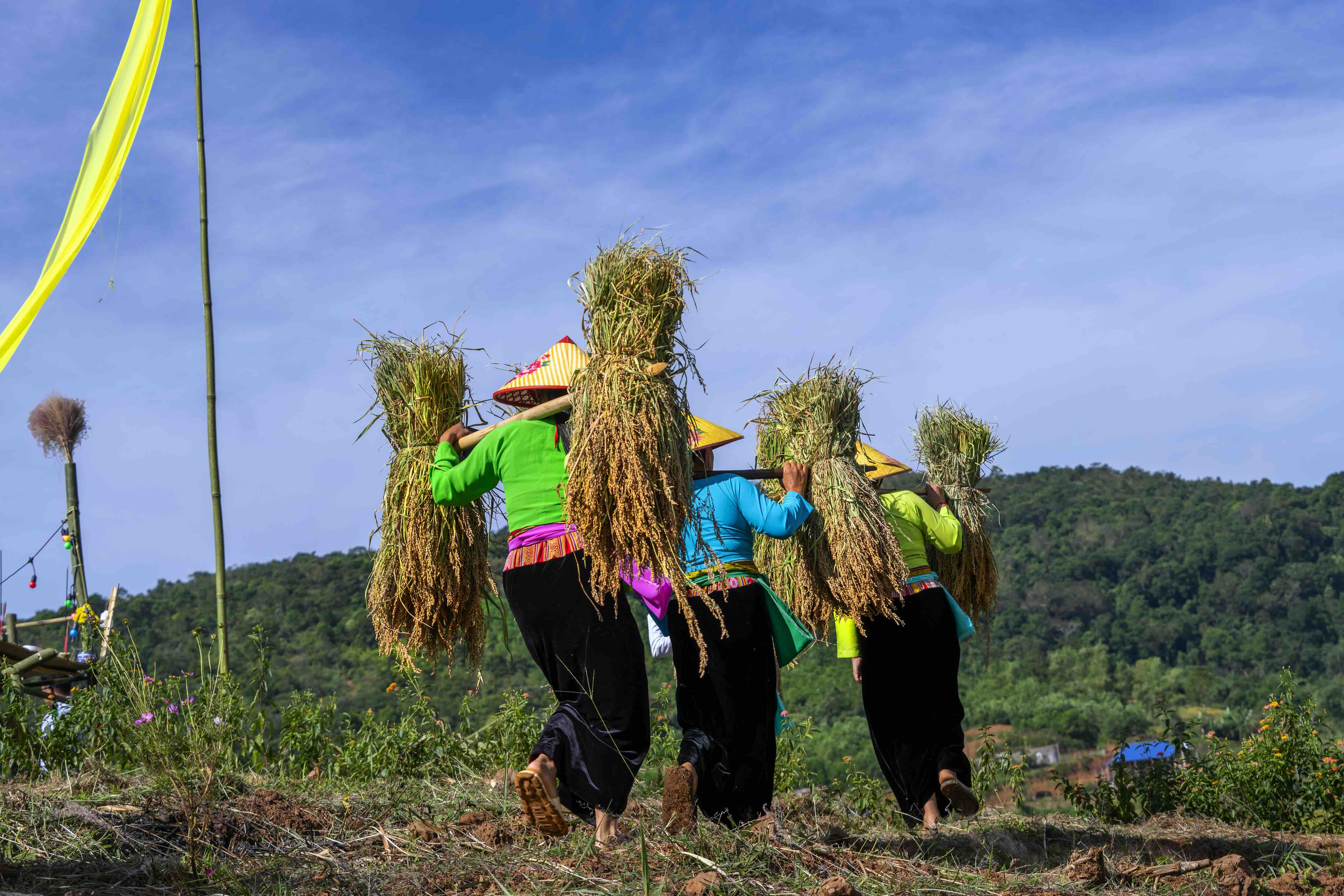Story: Prof. Dr. Trinh Sinh
Photos: Nguyen Thi Minh Hai
In the autumn, ethnic Muong people in Phu Tho Province celebrate their vibrant traditional New Year.
Having arrived in Thuong Coc Commune at the height of the ripe rice season, I was struck by the beauty of the semi-mountainous landscape, where terraced fields rolled like swathes of golden silk, stretching toward deep blue-green forests and a horizon of tinted green, beneath lazy white clouds. It was truly an ink-wash painting, woven by heaven and earth in the sunny, breezy autumn.

Among the festivals of the Muong people, the New Rice Festival is the most important. It is a time to celebrate the fruits of their labor, hard-earned through countless drops of sweat. Since ancient times, this day has also marked the beginning of the new year according to the Muong calendar, known as the Doi calendar. The first month of the Muong year falls in the 10th lunar month – in autumn, when the rice has just been harvested and the New Rice Festival is held.
The Muong have a saying: “Steamed rice, elevated house, carried water, roasted pig, retreating days, advancing months.” The phrase “retreating days, advancing months” refers to the Muong people’s unique method of timekeeping in the Doi calendar, made of 12 bamboo strips representing the 12 months.
Modernity has brought some changes to the lifestyle and festivals of the Muong community. However, some festivals are still observed with great reverence. For example, like many other ethnic groups, Muong people celebrate Tet Nguyen Dan (the Lunar New Year) but also hold their own Tet celebrations in the autumn. In the Muong language, Tet is called Thet, derived from the word Tiet, meaning seasons or weather.

The traditional Muong New Year, now commonly known as the New Rice Festival, is marked by vibrant celebrations that must include offerings of sticky rice, roasted pig, or grilled fish. Wearing a hat and holding a fan, the Mo Master takes the lead, guiding a procession to an outdoor altar made of bamboo poles, set near the rice fields. There, he prays to heaven, earth, and the spirits, asking for favorable rain, gentle winds, and abundant harvests.
On this festive day, women typically wear traditional clothing – white headscarves, short blouses, long skirts with brightly patterned waistbands, and an array of silver jewelry such as necklaces, earrings, and keychains, while walking and beating gongs. Men usually carry flags and beat drums. In addition to the communal ceremony, each family prepares a tray of new rice to offer to their ancestors. Near the altar, a bundle of rice woven from seven or nine stalks of sticky rice, picked from their fields, is often hung at the top of the house pillar.
As it retains many distinctive features, the Muong New Rice Festival is a unique intangible cultural heritage that attracts many tourists. In the 1930s, the French scholar V. Goloubew wrote: “The Muong consider themselves the ancestors of the An Nam people (the Kinh – Vietnam’s ethnic majority), while the An Nam people regard the Muong as siblings.” The factual basis of this view has been proven by many scholars from linguistic, archaeological, hematological, genetic, and cultural perspectives. Ancient Muong and Kinh shared the same origin, only separating later. Therefore, the customs and beliefs of the Muong ethnic group also help to deepen our understanding of Vietnam in general.

Having devoted her life to the Muong region, where she specialized in researching Muong rice cultivation practices, French scholar J. Cuisinier noted that Muong people use a rice-cutting knife called a nhip – smaller than a hand – to cut the first few bundles of rice and place them next to the ancestral altar, rather than using a sickle or reaper. Dating back to the Dong Son culture, this tool is still preserved in Muong rituals.
Muong offerings during the New Rice Festival also include many of the same items offered by Kinh people to greet the Lunar New Year, such as banh chung, banh gio, che lam, and banh gai. Muong people even break the banh chung into pieces and rub it on agricultural tools or the horns of buffaloes and cows, believing these objects have souls and must be blessed to help farmers achieve abundant harvests.
The New Year Festival of the Muong people in Thuong Coc is a valuable cultural heritage. Amid the broader development of the “cultural industry,” there remains a need to restore many of the festival’s traditional elements using ethnological and archaeological materials, to refresh and preserve this legacy.










